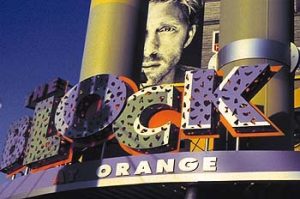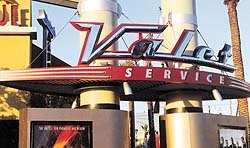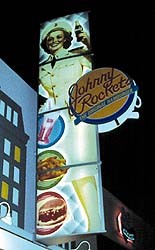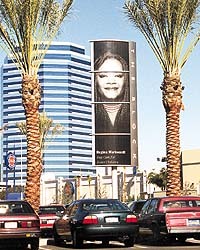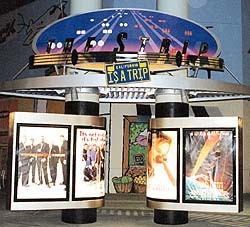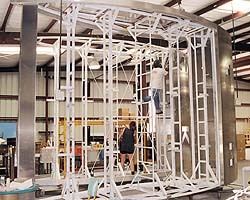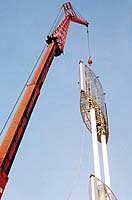To some, a sign is a mere mark or symbol: a gesture, an indication, a token, trace or symptom. But to others, a sign is a structure that is colossal in both size and impact; it’s an extraordinary sight worth seeing. For years, tourists have flocked to sign meccas like Las Vegas and Atlantic City not only in search of fortune, but also to witness the spectacular structures that help define the casino experience. But cities other than these lands of lost wages also harbor stunning signage. One such city is Orange County, CA.
Anchored by Anaheim and Buena Park, Orange County is known for its 42-mile-long, picturesque coastline, themed amusement parks, cultural monuments and historical museums. Each year, vacationers from around the world congregate to Orange County seeking pleasure from the region’s many attractions and plush scenery. And now, with the completion of The Block at Orange, Orange County offers tourists and natives another must-see attraction.
Located on The City Drive, at the intersections of three major Southern California highways (Interstate 75 and Highways 22 and 57), The Block at Orange is an 800,000-square-foot, $165 million outdoor shopping, dining and entertainment facility. It replaces an enclosed mall — named "The City" — that went out of business in 1995. In fact, "The City’s" remains were used as landfill for the new complex.
In addition to more than 100 specialty stores and restaurants, The Block at Orange includes the nation’s largest indoor skateboard park, the state’s largest surf shop and the county’s biggest multiplex cinema. This youth-oriented, entertainment extravaganza, located near Disneyland and Anaheim Stadium, expects to capitalize on more than 38 million tourists who visit Orange County annually.
In order to create a downtown-like atmosphere, the storefronts that line the mega mall’s two main walkways — the "Boulevard" and the "Strip" — are designed to resemble separate buildings. The center’s name, "The Block," is also meant to evoke the urban feel of famous downtown spots such as Times Square and Sunset Boulevard.
The Block at Orange is sure to impress its visitors. However, in addition to several entertainment venues and family-oriented activities, The Block at Orange features exceptional signage. The facility’s many mammoth signs create an impressive visual skyline and unique retail environment.
In February 1998, Arlington, VA-based The Mills Corp., the project’s developer, interviewed several sign companies to engineer, manufacture, deliver and install the center’s large-scale, exterior signage. With many mega-mall developments about which to boast, The Mills Corp. knew what it was seeking in a sign fabricator.
Glen Cove, NY- and Tampa, FL-based Universal Sign Corp. was contracted to fabricate the project’s atypical-sized signage. SmithCraft, Phoenix; Colour Concepts, Las Vegas; and Supercolor Digital, Irvine, CA; were among the shops hired to construct the mall’s not-so-large-scale displays, including its informational and directional signs and digitally printed graphics.
Founded in 1926 by Malcolm and Cyrille Steiner, Universal Sign has produced many recognized signs, including the world’s first internally illuminated sign in 1947 for Shell Oil Co. and the ball used for Times Square’s 1996 New Year’s Eve celebration. The company also built and installed more than 1,600 signs for the Tropicana Field baseball stadium located in St. Petersburg, FL.
Project design
Having worked with The Mills Corp. in the past on other mega-mall projects, Boulder, CO-based Communication Arts Inc. was contracted to design The Block’s exterior "look." To coincide with the center’s youth-oriented atmosphere, the project’s developer and designer were interested in producing a playful, yet flexible sign system. Both companies wanted to go beyond traditional, shopping-center signage and create something more fun and edgy.
With a design concept in mind, Communication Arts worked with the project’s Cambridge, MA-based architects, D’Argistino, Izzo, Quirk, to develop an exterior design package. In addition to the project’s signage, the designer and architects also planned the mall’s amenities, environmental graphics, decorative lighting and tenant storefronts.
Playing by the rules
The engineer of The Block’s large-scale signage involved a collaborative effort between Universal Sign and Communication Arts. Together, the companies transformed very complex design solutions into completed signs. According to Universal Sign President Lawrence Steiner and Vice President Jonathan Bell, this feat was a massive challenge. They elaborate, "Not only were the signs [engineered] and fabricated 3,300 miles from the [project’s] site, but they also had to be enormous in scale, size and complexity and meet strict California building requirements."
All of the mall’s signs — some measuring 91 feet tall — had to withstand Southern California’s earthquakes and 70-mph wind load. Also, some of the signs feature 60-foot-tall-by-17-foot wide, 200-pound, one-piece Flexface
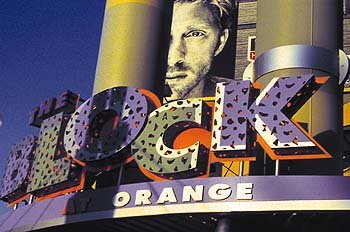

 Photo Gallery1 week ago
Photo Gallery1 week ago
 Ask Signs of the Times2 weeks ago
Ask Signs of the Times2 weeks ago
 Paula Fargo7 days ago
Paula Fargo7 days ago
 Real Deal4 days ago
Real Deal4 days ago
 Benchmarks2 weeks ago
Benchmarks2 weeks ago
 Photo Gallery7 days ago
Photo Gallery7 days ago
 Women in Signs2 weeks ago
Women in Signs2 weeks ago
 Women in Signs1 week ago
Women in Signs1 week ago
